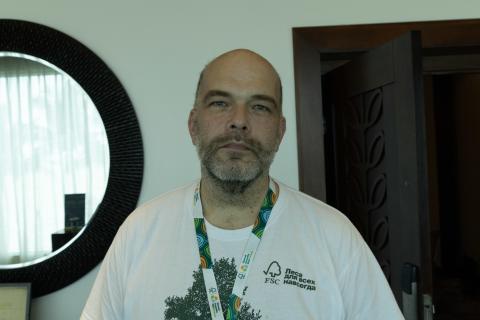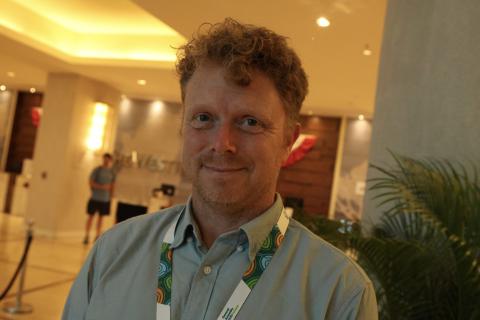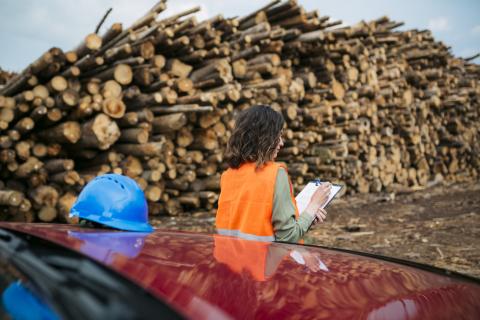Phil Guillery: What should FSC do to enhance traceability in the Chain of Custody system?
During the recent Forest Stewardship Council (FSC) General Assembly, Phil Guillery, Executive Director of World Forest ID, took some moments to talk with us about how the FSC can ensure and bring traceability to its Chain of Custody (CoC) system. Phil has worked for over 30 years to combat illegal logging, of which 10 years were with FSC as their former Supply Chain Integrity Director.
What is the current trend in enhancing traceability in the timber supply chain?
One of the most notable trends certainly is the use of blockchain systems, which has the potential to streamline timber supply chain management and improve traceability. Because of the blockchain’s immutable records. It is very hard to manipulate large volumes of certified material, as opposed to paper-based systems of verification, which are much more susceptible to fraud.
Another trend is the use of science-based testing, which is growing rapidly in different commodities. This includes various techniques, such as Stable Isotope Ratio Analysis or Genetic Testing, or even using trace elements. However, all these techniques depend on having reference datasets. And the last point, the availability of these reference datasets, is a shortcoming, one that World Forest ID is working to correct.
By bringing those two methods together, blockchain systems and science-based testing, we could make supply chain fraud extremely difficult. The idea would be to collect samples all along the supply chain, and then do random product testing, kind of like what is used for Olympic Doping Tests. So, one would never know if and when they might be tested. This would be more cost-effective as not all samples would need to be tested, but it would still put pressure on actors to comply.
And the last important trend I would mention is the use of machine learning, mainly within data analysis and field expedition planning. We are exploring how it can be used to reduce the number of samples required for reference datasets, identify key hotspots to sample, and increase the resolution of testing. This will help make science-based techniques less expensive and more accurate. Machine learning has huge potential that we are just beginning to understand and is definitely an emerging field to watch.
There have been many flaws and challenges within the FSC Chain of Custody system. What are they and what is FSC doing to address these problems?
One thing is that the audits happen only once a year and they only check one step up or one step down in the supply chain. This makes it difficult for an auditor to catch anything that has happened further down the supply chain. The only information they can confirm is whether the product conforms to the claim it came with. The current system works well for internal traceability, such as within a factory, but not for tracing products through long, complex supply chains.
FSC should bring traceability into its system. Blockchain systems can help provide that. FSC already has pilots working on this. We are also working with FSC to bring science-based testing into the system which will allow traceability systems to add a means for harvest origin verification. That is to verify that the product came from where it was claimed to be from. By using these new technologies, FSC can make its Chain of Custody system stronger and ensure better traceability.
How far have these measures been applied by FSC to fill these gaps?
My understanding is that these technologies are being piloted now. For example, we are working with Assurance Services International (ASI) and FSC to determine how to use science-based testing. We are working with both on how to expand reference datasets, so testing can be applied system-wide.
Talking about tracing the origin of timber in the FSC system. We all see the benefits it will bring. However, what are the obstacles to replicating it on a large scale and how can we overcome those?
This gets back to what World Forest ID, with FSC and ASI’s support, is working on to create the necessary reference datasets. This is a giant undertaking, as ideally, we should have reference datasets of all the traded timber species from their growing range. This will be an enormous number of samples that need to be taken from the forest.
As we collect these samples, we also need to make sure that the reference datasets are available, so that they can be widely used and that they are used in a credible manner. Also, it is important that people understand the limitations of science and technology. We need to focus on building out the reference data sets and make sure that we work with the additional number of labs.
How might new technology change the conventional way of auditing the supply chain?
Conventional auditing will become more focused on risk. Longer-term traceability will be easier for the auditor to conduct as well as verify the harvest origin of the wood. Auditors can then focus on making sure proper systems are in place and focusing on internal traceability. Essentially, this means making auditing faster and cheaper and directing the focus on where the risks might be.
The huge potential of machine learning is to make verification easier, faster, and cheaper. World Forest ID is working on this right now; we are investigating how we can use machine learning to improve the science, to eventually be able to collect fewer samples and achieve the same or better results with more impact. For example, by taking different technologies and combining them, e.g., DNA and Stable Isotope data, and seeing if we can get better answers and get higher resolution from the data sets we already have.
This, combined with the science, once we have the reference data, will help accelerate the use of these technologies. The interesting question is, where else could machine learning help with traceability, auditing and verification? Can it help identify risks? Identify trends. Tell us where and when the audits should take place.



